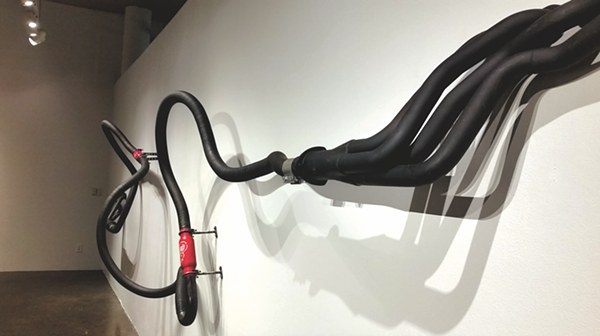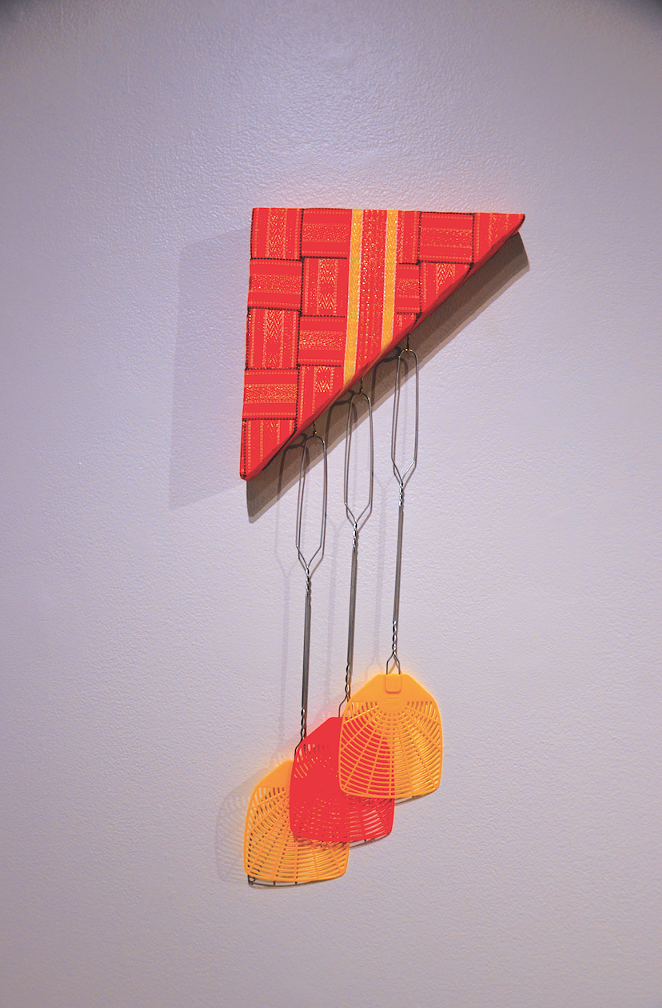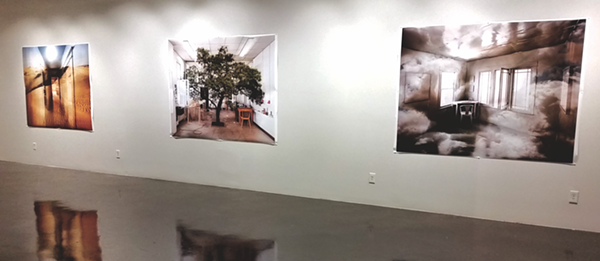Buster Graybill: ‘Leisure Lines’
If pioneering abstractionist Frank Stella had grown up in East Texas, he might have come up with something similar to the striped, clean-lined assemblages San Antonio artist Buster Graybill is showing in “Leisure Lines” at the Southwest School of Art through November 12. From the University of Texas at San Antonio assistant professor’s “Recreational Modernism” series, his “paintings” made with brightly colored and patterned lawn chair straps are part of an exploration of “modernist tendencies through a rural, working-class perspective.”
Working with things you can probably find in your backyard or garage — polypropylene lawn-chair webbing, flyswatters, badminton shuttlecocks, exhaust pipes and Frisbees — Graybill evokes the simple, soothing lines of highbrow minimalism with decidedly lowbrow materials. For Shuttlecock, he wrapped white webbing around wood panels to form a checkerboard-like, monochromatic background on a pair of offset squares. Green-and-orange plaid stripes run through the piece, and the shuttlecocks are lined up on a small ledge like they’re waiting for a game.
Oddly cheerful bright-yellow flyswatters hang from one piece, while Frisbees are the focus of two Target constructions. Hooker Headers, Cherry Bomb glasspack mufflers and exhaust pipes are attached to the wall in tangled lines in Exhausted, but most of the spare, rectangular web-works in “Leisure Lines” are quietly elegant.
However, as you walk around the gallery, you’ll notice bits and pieces of clay pigeons crunching under your shoes, evidence of a creative violence not evident in most of the show. For Shoot: 2017, Graybill used an automatic skeet thrower to fire 405 clay pigeons at a blank canvas. Some missed and wound up hitting the wall, but the resulting painting is fairly delicate and subdued, with shadowy orange and black marks similar to a classic Japanese painting of fog and smoke.
Graybill’s 2010 Artpace residency installation, Progeny of Tush Hog, featured sculptural hog feeders that curator Helen Molesworth of the Institute of Contemporary Art/Boston described “as if the contemporary aesthetics of a Donald Judd sculpture escaped Marfa, Texas, and crossbred with the rural functionality of a deer feeder,” which belonged “in a pick-up truck bed, rather than an art gallery.” In “Leisure Lines,” Graybill takes the tacky materials of rural Texas and transforms them into regal compositions that would not look out of place in the poshest, high-end New York gallery.
Chris Engman: ‘Prospect and Refuge’
In these days of digital magic, it’s rare to have an “Oh, wow!” moment looking at a photograph. When everything is possible, nothing is exceptional. But Los Angeles artist Chris Engman doesn’t rely on computer wizardry to create his weirdly surrealistic images. Instead, he constructs elaborate, labor-intensive installations, which he uses a camera to document.
For example, a tree appears to be growing in the middle of a studio in his Landscape for Candace. But when you look at the top of the picture, you notice parts of the tree limbs appear to be falling down, peeling off the ceiling like old wallpaper. The “tree” is actually photographic prints that have been glued or attached to all the surfaces in the architectural space. But Engman allows small imperfections to reveal how much work actually went into building the image.
The key image in Engman’s “Prospect and Refuge” (also on view through November 12 at the Southwest School of Art) is Prospect, which appears to be the ocean and an endless horizon tucked into the corner of a small, safe room. Engman is inspired by the theories of British writer Jay Appleton, who believes two of humanity’s most basic needs are for opportunity and shelter. Prospect brings the outside inside, contrasting the wide-open possibilities of adventure and discovery in the natural world with the more internal, introspective nature of the artist in his or her studio.
For Refuge, he printed the image of a wooded scene onto more than 150 pieces of paper, which were then hand-cut and affixed to the walls and objects within a sunlit room with several windows. Then he photographed the installation and printed it on a single sheet of paper. While the trick is less obvious, you can see the seams between the prints if you look closely. In his artist statement, Engman notes “everything about the presentation is designed to deny that the paper exists at all. What matters and is emphasized is the illusion, or, if you like, the lie.”
In Containment, he recreated a canyon in Zion National Park in Utah, using photos he took during a hike through the towering cliffs carved out by the Virgin River plastered over more than 200 surfaces in his studio. Dimly, you can see the outlines of fluorescent lights and a small square window.
With a 2013 MFA from the University of Southern California, Engman is already set for his first career survey in 2018 at the Museum of California Art in Pasadena. He combines photography and sculpture to examine the tension between personal safety and adventure, but his images also reflect an artist’s unbounded imagination.
‘Leisure Lines’ & ‘Prospect and Refuge’ through November 12
Free, 9am-5pm Mon-Sat, 11am-4pm Sun, Southwest School of Art, 300 Augusta St., (210) 224-1848, swschool.org




